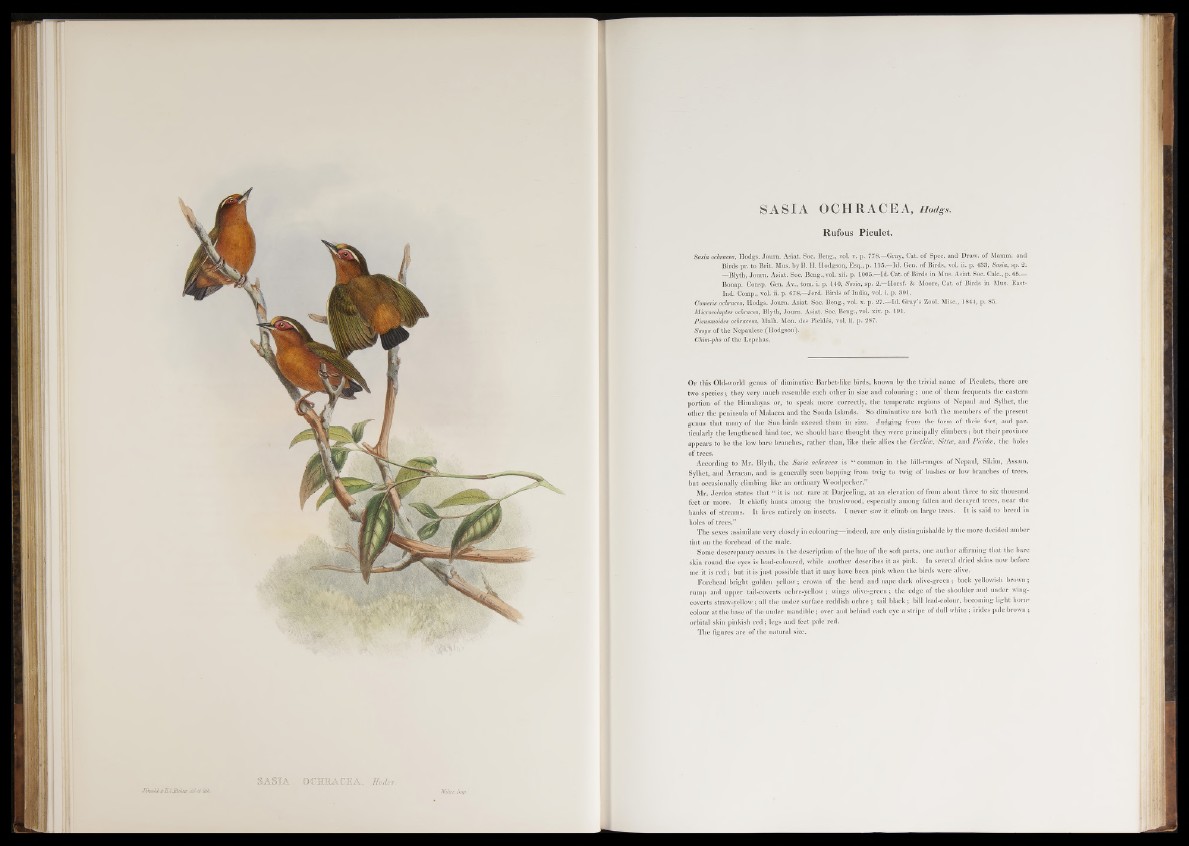
SASIA OCHRACEA, Hodgs.
Rufous Piculet.
Sasia ochracea, Hodgs. Journ. Asiat. Sog. Beng., vol. v. p. 778.—Gray, Cat. o f Spec, and Draw, o f Mamrn. and
Birds pr. to Brit. Mus. by B. H. Hodgson, Esq., p. 115.—Id. Gen. of Birds, vol. ii. p. 433, Sasia, sp. 2.
—Blyth, Journ. Asiat. Soc. Beng., vol. xii. p. 1005.—Id. Cat. of Birds in Mus. Asiat. Soc. Calc., p. 65.—
Bonap. Consp. Gen. Av., tom. i. p. 140, Sasia, sp. 2.—Horsf. & Moore, Cat. of Birds in Mus. East-
Ind. Comp., vol. ii. p. 678.—Jerd. Birds of India, vol. i. p. 301.
Comer is ochracea, Hodgs. Journ. Asiat. Soc. Beng., vol. x. p. 27.—Id. Gray’s Zool. Misc., 1844, p. 85.
AJicrocolaptes ochracea, Blyth, Journ. Asiat. Soc. Beng., vol. xiv. p. 191.
Picumnoides ochraceus, Malik. Mon. des Picidés, vol. ii. p. 287.
Sasya of the Nepaulese (Hodgson).
Chim-pho of the Lepchas.
O f this Old-world genus of diminutive Barbet-like birds, known by the trivial name of Piculets, there are
two species; they very much resemble each other in size and colouring; one of them frequents the eastern
portion of the Himalayas or, to speak more correctly, the temperate regions of Nepaul and Sylhet, the
other the peninsula of Malacca and the Sonda Islands. So diminutive are both the members of the present
genus that many o f the Sun-birds exceed them in size. Judging from the form of their feet, and particularly
the lengthened hind toe, we should have thought they were principally climbers; but their province
appears to be the low bare branches, rather than, like their allies the Certhice, S itta , aud Picidce, the boles
of trees.
According to Mr. Blyth, the Sasia ochracea is “ common in the hill-ranges o f Nepaul, Sikim, Assam,
Sylhet, and Arracan, and is generally seen hopping from twig to twig of bushes or low branches of trees,
but occasionally climbing like an ordinary Woodpecker.”
Mr. Jerdon states that “ it is not rare at Darjeeling, at an elevation of from about three to six thousand
feet or more. It chiefly hunts among the brushwood, especially among fallen and decayed trees, near the
banks of streams. It lives entirely on insects. I never saw it climb on large trees; It is said to breed in
holes of trees.”
The sexes assimilate very closely in colouring—indeed, are only distinguishable by the more decided amber
tint on the forehead of the male.
Some descrepancy occurs in the description of the hue of the soft parts, one author affirming that the bare
skin round the eyes is lead-coloured, while another describes it as pink. In several dried skins now before
me it is red; but it is just possible that it may have been pink when the birds were alive.
Forehead bright golden yellow; crown of the head and nape dark olive-green; back yellowish brown;
rump and upper tail-coverts ochre-yellow; wings olive-green; the edge of the shoulder and under wing-
coverts straw-yellow; all the under surface reddish ochre; tail black; bill lead-colour, becoming light horn-
colour at the base of the under mandible; over and behind each eye a stripe of dull white ; irides pale brown ;
orbital skin pinkish red; legs and feet pale red.
The figures are of the natural size.